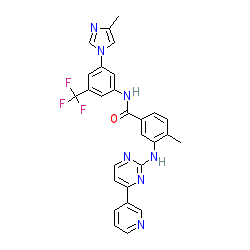|
Synonyms: AMN 107 | AMN107 | Tasigna®
nilotinib is an approved drug (FDA & EMA (2007))
Compound class:
Synthetic organic
Comment: Nilotinib is a Type-2 kinase inhibitor and was first approved by the FDA in 2007.
Preclinical studies in rodent Parkinson's disease models suggest that nilotinib has some potential to promote autophagic degradation of α-synuclein [4-6,9], a brain protein whose accumulation and aggregation contributes to the formation of toxic insoluble fibrils which cause pathological changes such as neuronal loss in Parkinson's disease and other synucleinopathies. This mechanism has been evaluated in a pilot, proof-of-concept and safety clinical trial in a small number of patients with Parkinson's disease- and diffuse Lewy body disease-associated cognitive impairment (see NCT02281474; note that this trial is not placebo controlled or blinded). Ligand Activity Visualisation ChartsThese are box plot that provide a unique visualisation, summarising all the activity data for a ligand taken from ChEMBL and GtoPdb across multiple targets and species. Click on a plot to see the median, interquartile range, low and high data points. A value of zero indicates that no data are available. A separate chart is created for each target, and where possible the algorithm tries to merge ChEMBL and GtoPdb targets by matching them on name and UniProt accession, for each available species. However, please note that inconsistency in naming of targets may lead to data for the same target being reported across multiple charts. ✖
View more information in the IUPHAR Pharmacology Education Project: nilotinib |
|
|||||||||||||||||||||||||||||||||||
| References |
|
1. Anastassiadis T, Deacon SW, Devarajan K, Ma H, Peterson JR. (2011)
Comprehensive assay of kinase catalytic activity reveals features of kinase inhibitor selectivity. Nat Biotechnol, 29 (11): 1039-45. [PMID:22037377] |
|
2. Davis MI, Hunt JP, Herrgard S, Ciceri P, Wodicka LM, Pallares G, Hocker M, Treiber DK, Zarrinkar PP. (2011)
Comprehensive analysis of kinase inhibitor selectivity. Nat Biotechnol, 29 (11): 1046-51. [PMID:22037378] |
|
3. Gao Y, Davies SP, Augustin M, Woodward A, Patel UA, Kovelman R, Harvey KJ. (2013)
A broad activity screen in support of a chemogenomic map for kinase signalling research and drug discovery. Biochem J, 451 (2): 313-28. [PMID:23398362] |
|
4. Hebron ML, Lonskaya I, Moussa CE. (2013)
Nilotinib reverses loss of dopamine neurons and improves motor behavior via autophagic degradation of α-synuclein in Parkinson's disease models. Hum Mol Genet, 22 (16): 3315-28. [PMID:23666528] |
|
5. Hebron ML, Lonskaya I, Moussa CE. (2013)
Tyrosine kinase inhibition facilitates autophagic SNCA/α-synuclein clearance. Autophagy, 9 (8): 1249-50. [PMID:23787811] |
|
6. Karuppagounder SS, Brahmachari S, Lee Y, Dawson VL, Dawson TM, Ko HS. (2014)
The c-Abl inhibitor, nilotinib, protects dopaminergic neurons in a preclinical animal model of Parkinson's disease. Sci Rep, 4: 4874. [PMID:24786396] |
|
7. Kim HG, Tan L, Weisberg EL, Liu F, Canning P, Choi HG, Ezell SA, Wu H, Zhao Z, Wang J et al.. (2013)
Discovery of a potent and selective DDR1 receptor tyrosine kinase inhibitor. ACS Chem Biol, 8 (10): 2145-50. [PMID:23899692] |
|
8. O'Hare T, Walters DK, Stoffregen EP, Jia T, Manley PW, Mestan J, Cowan-Jacob SW, Lee FY, Heinrich MC, Deininger MW et al.. (2005)
In vitro activity of Bcr-Abl inhibitors AMN107 and BMS-354825 against clinically relevant imatinib-resistant Abl kinase domain mutants. Cancer Res, 65 (11): 4500-5. [PMID:15930265] |
|
9. Tanabe A, Yamamura Y, Kasahara J, Morigaki R, Kaji R, Goto S. (2014)
A novel tyrosine kinase inhibitor AMN107 (nilotinib) normalizes striatal motor behaviors in a mouse model of Parkinson's disease. Front Cell Neurosci, 8: 50. [PMID:24600352] |
|
10. Wodicka LM, Ciceri P, Davis MI, Hunt JP, Floyd M, Salerno S, Hua XH, Ford JM, Armstrong RC, Zarrinkar PP et al.. (2010)
Activation state-dependent binding of small molecule kinase inhibitors: structural insights from biochemistry. Chem Biol, 17 (11): 1241-9. [PMID:21095574] |








